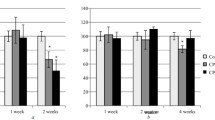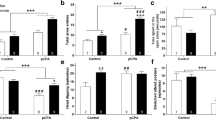Summary
The effects of neonatal treatment with clomipramine on the sensitivity of cholinergic receptor and passive avoidance behavior were studied to examine the activity of the central cholinergic system. Rat pups were treated twice daily from postnatal day 5 to 21 with clomipramine (15mg/kg, s.c.) and at 3 months of age the thermic responses to three different doses of oxotremorine were measured. One day following oxotremorine challenge study, the animals were subjected to passive avoidance training and retention was measured 24-hr later. Clomipramine treated animals showed an enhanced cholinomimetic — induced hypothermia and an increased latency in passive avoidance test. These findings may reflect an altered sensitivity of central cholinergic system in rats given clomipramine as neonates. The results were compared to other animal models of depression.
Similar content being viewed by others
References
Buresova O, Bures J (1983) Learning and memory. In: Bures J, Buresova O, Houston JP (ed) Techniques and basic experiments for the study of brain and behaviour. Elsevier, New York, pp 155–156
Dilsaver SC (1986) Cholinergic mechanisms in depression. Brain Res Rev 11: 285–316
Dilsaver SC, Alessi NE (1987) Chronic inescapable foot shock produces cholinergic system supersensitivity. Biol Psychiatry 22: 910–914
Dilsaver SC, Snider RM, Alessi NE (1986) Stress induced supersensitivity of the cholinergic system in rats. Biol Psychiatry 21: 1093–1096
Dilsaver SC, Snider RM, Alessi NE (1987) Amitriptyline supersensitizes a central cholinergic mechanism. Biol Psychiatry 22: 495–507
Gardner R, Ray J, Frankenheim K, Wallace M, Loos M, Ribochand R (1984) A possible mechanism for diisopropyl fluorophosphate induced memory loss in rats. Pharmacol Biochem Behav 21: 43–46
Hartley P, Neill D, Hagler M, Kors D, Vogel G (1990) Procedure and age — dependent hyperactivity in a new animal model of depression. Neurosci Biobehav Rev 14: 69–72
Janowsky DS, El-Yousef MK, Davis JM, Serkerke HJ (1972) A cholinergic — adrenergic hypothesis of mania and depression. Lancet ii: 6732–6735
Loullis CC, Dean RL, Lippa AS, Meyerson LR, Beer B, Bartus RT (1983) Chronic administration of cholinergic agents: effects on behavior and calmodulin. Pharmacol Biochem Behav 18: 601–604
Mirmiran N, Van de Poll N, Corner H, Van Oyen H, Boer G (1981) Supression of active sleep by chronic treatment with clomipramine during early postnatal development: effects upon adult sleep and behavior in the rat. Brain Res 204: 129–146
Neill D, Vogel G, Hagler M, Kors D, Hennessey A (1990) Diminished sexual activity in a new animal model of endogenous depression. Neurosci Biobehav Rev 14: 73–76
Overstreet DH (1986) Selective breeding for increased cholinergic function: development of a new animal model of depression. Biol Psychiatry 21: 49–58
Overstreet DH, Rezvani AH, Janowsky DS (1992) Genetic animal models of depression and ethanol preference provide support for cholinergic and serotonergic involvement in depression and alcoholism. Biol Psychiatry 31: 919–936
Shiromani PJ, Gillin JC, Henriksen SJ (1987) Acetylcholine and the regulation of REM sleep: basic mechanisms and clinical implications for affective illness and narcolepsy. Ann Rev Pharmacol Toxicol 27: 137–156
Shiromani PJ, Overstreet DH, Levy D, Goodrich GA, Campbell S, Gillin JC (1988) Increased REM sleep in rats selectively bred for cholinergic hyperactivity. Neuropsychopharmacology 1: 127–183
Vogel G, Hartley P, Neill D, Hagler M, Kors D (1988a) Animal depression model by neonatal cloipramine: reduction of shock induced aggression. Pharmacol Biochem Behav 31: 103–106
Vogel G, Neill D, Hagler M, Kors D (1990a) A new animal model of endogenous depression: a summary of present findings. Neurosci Biobehav Rev 14: 85–91
Vogel G, Neill D, Hagler M, Kors D, Hartley P (1990b) Decreased intracranial self stimulation in a animal model of endogenous depression. Neurosci Biobehav Rev 14: 65–68
Vogel GW, Roth T, Gillin JC, Mendelson WC, Buffenstein A (1988b) REM sleep and depression. In: Oniani T (ed) Neurobiology of sleep-wakefulness cycle. Metsniereba, Tbilisi, USSR, pp 187–214
Vogel GW, Vogel FA (1982) A new animal model of endogenous depression. Sleep Res 11: 222a
Whitaker-Azmitia MP (1991) Role of serotonin and other neurotransmitter receptors in brain development: basis for developmental pharmacology. Pharmacol Rev 43: 553–559
Zerbib R, Laborit H (1990) Chronic stress and memory: implication of the central cholinergic system. Pharmacol Biochem Behav 36: 897–900
Author information
Authors and Affiliations
Rights and permissions
About this article
Cite this article
Prathiba, J., Kumar, K.B. & Karanth, K.S. Effects of neonatal clomipramine on cholinergic receptor sensitivity and passive avoidance behavior in adult rats. J. Neural Transmission 100, 93–99 (1995). https://doi.org/10.1007/BF01271532
Received:
Accepted:
Issue Date:
DOI: https://doi.org/10.1007/BF01271532




